What am I doing with Arduino and Raspberry Pi?
Hello.
My Facebook disciple know more already then my beloved blog reader. A few days ago I posted the following pictures in Facebook:
The description was:
Da bomb is in da house… and working quite fine :)
What is that, beside of a beautiful piece of art of colored wires and electric stuff.
Of course it is not exploding :) It is a small stand-alone measuring station. It contains:
1x Arduino Pro Mini -> The micro controller which is processing all the data
1x Power supply -> No cool e-stuff without a bit electricity
2x Photo resistor -> to measure the amount of light around (of course, both give different values… ^^)
1x DHT11 -> Measures temperature and humidity
1x DHT22 -> Measures temperature and humidity as well… the newer model of the DHT11
1x LM35 -> Measures temperature… I fucked it when I mistaken plus and minus :( It is still sending values… but useless ones.
1x MQ-2 -> Measures the amount of smoke/lpg/co gas in the air.
1x 1.8” TFT with SD card -> To display the values and it is also writing all data in a log file on a sd card for later processing.
So far… will be continued… :)
So… why do I play around with it?
An Arduino is a micro controller. Actually a micro controller on a board with some more stuff, to make it easier to work with it for the people. It got invented from Massimo Banzi and David Cuartielles (and named after a pub… yeah yeah :) ). David Mellis developed the programming language for it. The whole system is open source. That means everybody can see the sources, how it works. That’s why there are also copies of the original Arduino available and even you could solder your own one. It’s a quite easy way to get in touch with the micro controller stuff.
But lets have a look to another kind. As I mentioned in the headline already, there is also a ‚Raspberry Pi‘.
The Raspberry Pi is similar to Arduino, but also different. The Raspberry Pi is more a micro computer then a controller. He consist a 700MHz ARM processor (the same CPU architecture as in mobile phones), 512MB RAM, etc. As operating system is usually Linux installed. Here is one big difference, the Raspberry Pi have a operating system, the Arduino doesn’t.
So, what does it mean now?
Both boards have GPIO pins. That are connectors on which we can connect sensors and such sttuff. One sensor is for example the DHT22… a sensor which is measuring the temperature and humidity. I can connect this sensor now to the Arduino and the Raspberry Pi. A small program written and it will show me the values of the sensor.
So, one board is enough!?
In general yes. But it is always a question of what we want to do.
With the Raspberry Pi the possibilities are much bigger, because we can make a lot more with the board as just reading sensor values. We have much more storage available. We can install software and have even a GUI (graphic user interface). We can write emails, texts, we can program and much more. Its a full computer, just a bit limited in its resources. But therefore it consumes more electricity.
I mean ‚consuming more electricity‘ is relative here. 3.5 Watt is usually not worth a word! But if you want to create (for example) a stand alone weather which have a battery as power supply, then is 3.5 watt a very bad consumption and the weather station will not even run 1 day. Here is a solution needed which is running with as less power as possible. And here comes the Arduino in the game. That is his strength. Doing a job (like reading sensor values) and consume almost no electricity.
Why do I get in touch with this strange stuff?
Don’t worry, I didn’t went to become a bomb builder;) (Hello NSA… and again a match with a keyword… congratulation! ;) )
Well, some know that I have a new project in my head. I want to travel around with a camper. To do so, I need to take my work with me. That means internet and electricity in the camper. But power will be very limited and my current computer have a consumption of approx 200 watt. So, this one is out of the game. I need a more battery-saving alternative is needed. Then I ‚met‘ the Raspberry Pi. It was clear that this small computer can not replace a working station, but it can be used to do at least some of the job. 3.5 watt is a good number for a 24h server. Even 3.5 * 24 is also 84 watt per day – in the theory – but I hope in praxis it will be a bit less, as the RPi is slowing down in times of not usage. I just testing it with a 10.400 mAh battery.
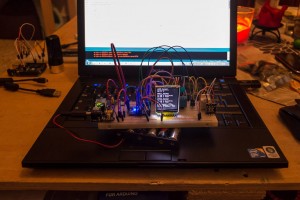 But I guess the RPi will be quite busy with all the task I have in mind for it :) As following:
But I guess the RPi will be quite busy with all the task I have in mind for it :) As following:
- NAS with external SSD
- Local web server for development
- Automatic connection control system for internet sources (Sat-DSL, WLAN, GPRS, etc.)
- Desktop for internet, watching movies, programming, etc.
- Central data processing unit for decentralized Arduinos with their sensors (weather sation (somewhere outside), camera modul in the front of the camper, motor sensor, gas sensro, etc.)
The are the rough tasks which the poor little guy needs to do.
I also need to note that I am testing the little PRi already and I need to mention that I am absolutely positive surprised. The little guy is not that weak as I thought. (Always with the consumption of 3.5 watt in mind… CPU without cooling!). The GUI is running properly. Also movies running with VLC. Icedove (the Linux version of Mozilla Thunderbird) needs a few more seconds, until its loading my several thousand emails. But then its ready for use. LibreOffice (like MS Office) the same. There are even games for the Raspberry Pi. I tried Mindcraft for a while and it is running smoothly.
As I said, with the hardware in mind, is this little computer a technical marvel.
And the Arduino joint my ‚tool box‘ when my play instinct got activated. :) This stuff is so awesome for me now, that I can’t stop playing with it :) Real addiction factor! When you made your first circuit, the first script is written and transferred to the Arduino and the LED really starts to blink… then you feel a bit like god… ‚This LED is blinking now because I wanted it!‘ :D
And then further… measuring temperatures, lighting up LEDs, reading light intensity (is it night, how strong is the sun shining, etc.), reading GPS coordinates and showing on a map, flame sensor (is it burning?), noise sensor, displays to show information, … and much more. The possibilities are almost endless. With a bit of creativitiy is it possible to make some really cool projects.
And in MY endless creativity (*cough*) I have the following projects in mind (in the camper).
- Weather station with sensor for temperatur, humidity, air pressure, light intensitiy, Geiger-Müller tube, GPS, etc.
- Camera module in front of the camper, which is making a picture every hour and is uploading it when internet connection is online)
- Gas sensor at the gas bottles, in the kitchen and at the heating. Also gas sensor for the gas which the thieves like to use.
- Connction to the engine electronic. For example to read the error buffer of the engine computer. Its not with every car possible… will see.
I think to remove the doorhandles and use instead a key card / fingerprint reader to open the doors. Instead of a key. The would confuse some thieves. ;)
Of all this data I want to make my own little black-box. But primarily I want to store this data in a database and put it online that everybody (who is interested) can see the data. (GPS data for security reasons with a time delay, of course ;) ) But that is all still up in the air. At the moment I still play around with both boards and try to build some stable systems. To test and get experience with it.
So, if you want to have a look at the micro controller world, then check out Arduino and / or the Raspberry Pi. I can highly recommend both systems. Is fun like hell and not hard to learn at all.
Best wishes
Gordon

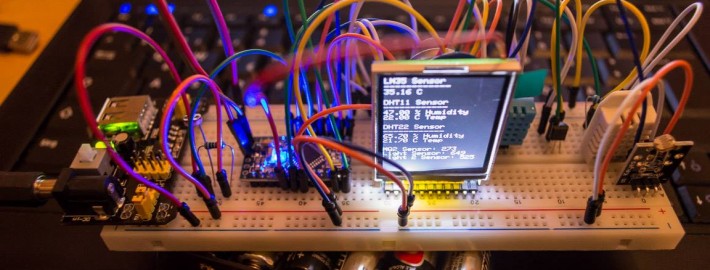
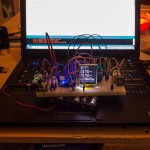
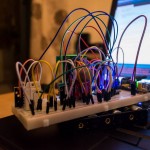
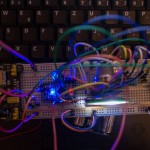
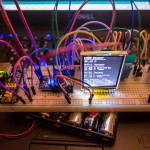






Letzte Kommentare